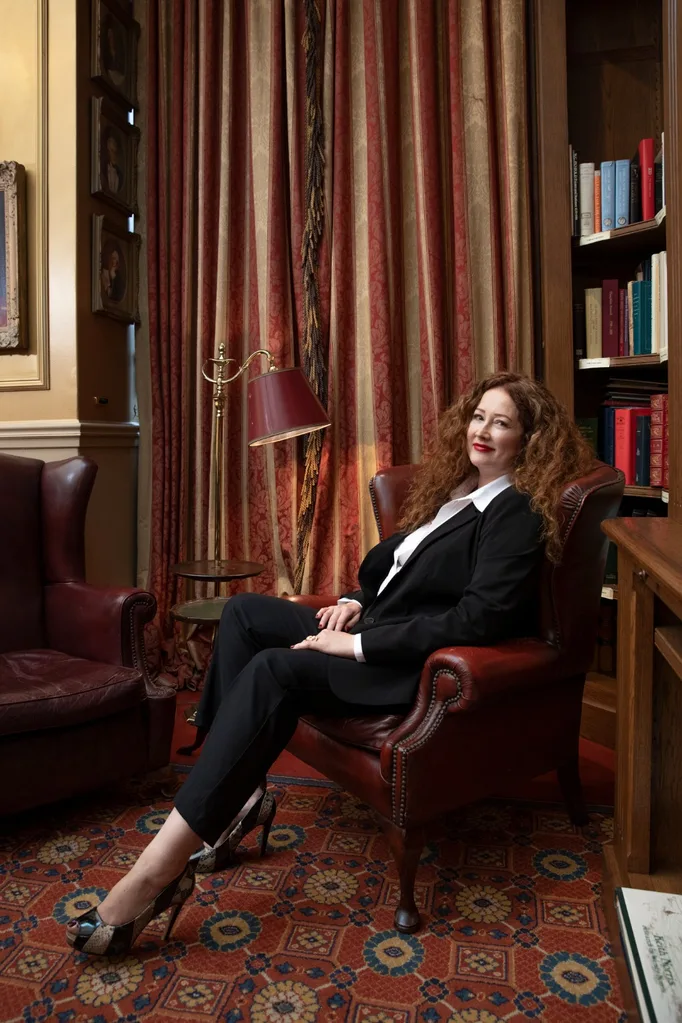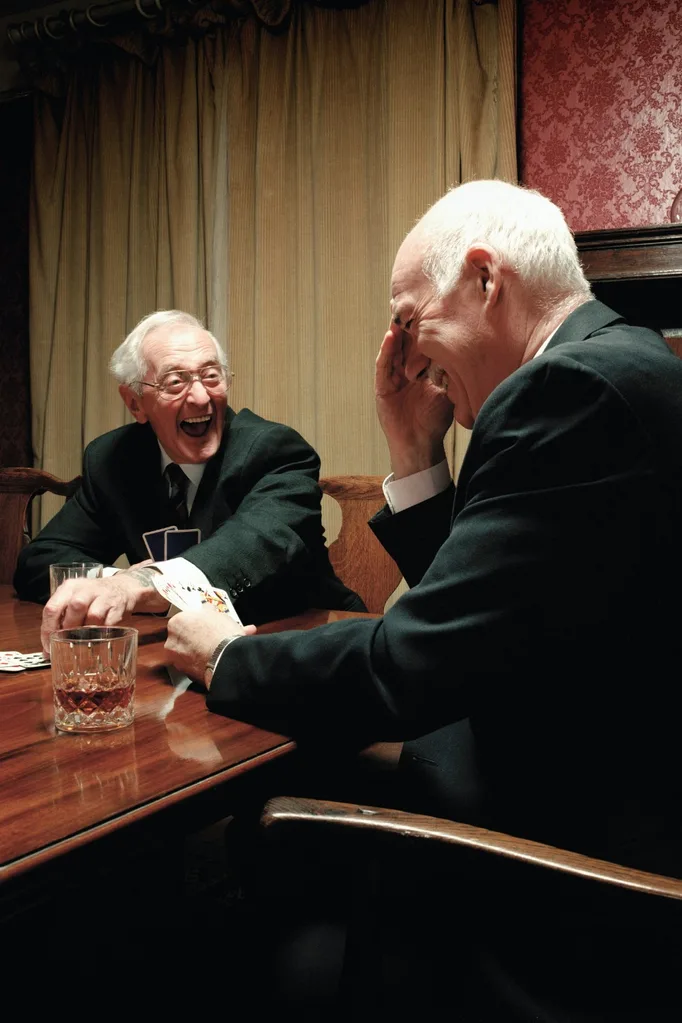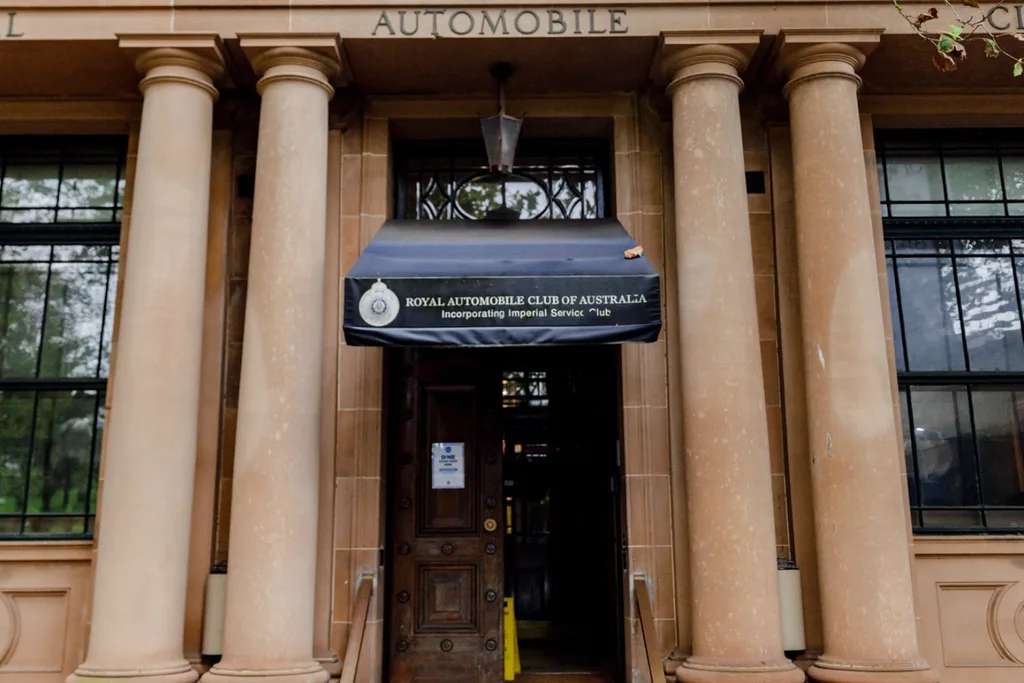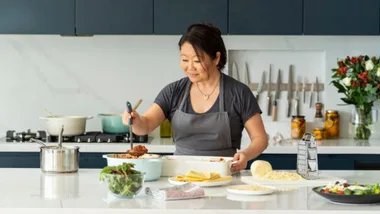I’m ensconced in a brown leather chesterfield in one of Sydney’s oldest private clubs. The very words conjure 19th-century alpha masculinity: cigar smoke spiralling in the air, glasses of brandy swirling in giant snifters, the “pock” of a billiard cue in the background. One would expect to discover a room full of men, partying like it’s 1899. Instead, I’m chatting to several other females enjoying the historic space their membership gives them access to.
My father, John – who graduated alongside Germaine Greer, picketing in the 1960s for women to be able to drink in the same bar at his local pub – sponsored me for membership at his club, the Royal Automobile Club of Australia, and delighted in the ritual of passing the baton from father to daughter.

Established in 1903 as a motoring club, the affectionately dubbed RACA has its roots in a passion for cars. I had always loved visiting Dad there for lunch, kicking it old-school in the hushed atmosphere of this miraculously preserved building. Dining under the glorious, tinted glass of the sky-high ceiling in the Victoria Room or curling up with a Dark and Stormy cocktail in the Pioneers Room, lined with books and a (sigh) library ladder, the ferry tooting of Sydney’s Circular Quay is, surreally, only minutes away outside.
Like so many male members before me, I can now say to business contacts, colleagues and friends “meet me at the RACA”. Meetings with a copywriting client of mine, a female owner-founder of a $50 million company, would turn into riotous all-afternoon brainstorms: the peace, privacy and surroundings reframed our work sessions as a convivial meeting of like-minded souls – personal, but with the backup of welcoming support staff.
“Everything is co-ed at the RACA,” enthuses Megan J. Lavender, the first female president in the club’s 119-year history, appointed in a deliberate bid by the club to diversify. “Women are actively engaged, involved and welcomed as participants in club life. Even in the early pre-membership years, the first female race car drivers happily mixed here with the gentleman drivers of the day,” says Lavender, conjuring up a wonderful image of derring-do: 1920s Jazz Age flappers with a need for speed. The preservation of the club’s time-warp surroundings, such as an extraordinary billiards table and curvilinear wooden phone booth straight out of a Hitchcock movie, are a huge part of the club’s charm, yet the RACA has a relatively egalitarian past: it allowed female members back in 1945.

Ever since the rise of private clubs in 1700s London, men have sought sanctuary in high-society havens with all the pleasures and convenience of their own private world, existing somewhere between the twin pillars of work and domesticity. In an era when women were sidelined from public life, they missed out on this invaluable opportunity to network, escape and luxuriate in these cloistered communities by default. If anything, the whole point of a gentleman’s retreat was to escape into sacrosanct male-only company.
Fast forward to the 21st century’s brave new world, as women are now overwriting the blueprint of what is possible more and more, and society re-examines itself through the prism of social justice movements such as #MeToo. Not only is the line between genders blurring, so is the very idea of gender itself. But what of the establishment clubs founded by men, for men, whose only female presence has traditionally been the portrait of the Queen on the wall?
There have been some holdouts against women members, such as London’s Savile Club and the thespian-influenced Garrick Club (Stephen Fry is a member). Sydney’s Australian Club, a bastion of elite political influence, voted to remain male-only last year. Apparently, those boys just want to have fun. Alone.
But many fabled clubs, prized for the gravitas of their old-world atmosphere, are welcoming women as members, embracing the culture shift and wider entrepreneurial pool. A great boon for women who travel for business or pleasure is that your home club can request access to inaccessible reciprocal clubs around the world with a letter of introduction. This was how, on my last trip to London, I first discovered the Naval and Military Club – universally known as the In & Out – as an overnight guest. Founded in 1862, it is slap bang in St James’ Square, buzzing with social parties, home county accents, balloon chandeliers and an Elizabeth Bennett-worthy sweeping staircase.
Member Serena Joseph explains on the phone from London how invaluable her club has been since she branched out to work for herself in the world of financial services regulation, commuting between her Essex home and London. “I joined in 2008 when I left one of the big companies to set up my own business. I was still on mum duty with young children, so I needed a space of my own. I didn’t want to hover in coffee shops between meetings, looking for the loo.” Her first requirement was a club that embraced men and women equally. “It felt too old-fashioned to piggyback as a guest; I wanted to entertain clients in my own right, not as an appendage. As a member, I can use the business centre, book big rooms for client meetings and run work events with canapés.”

Joseph believes that private clubs can reduce the juggling act of motherhood as a woman’s career advances, especially navigating the un-family-friendly world of investment banking and the culture of the eight o’clock meeting. “I could do tea/bath/storytime with the children, attend client dinners then stay overnight at the In & Out, avoiding a three-hour round trip,” she explains. “The staff welcome means you never feel like you’re camping out.”
In our disconnected age of screens over faces, the chummy sense of behind-closed-doors togetherness couldn’t be timelier. “It’s 2022, post Covid, and we all need to connect again,” declares Ms Pearls (aka Paula Scholes), the bubbly general manager of private club The Kelvin, tucked away in the heart of Melbourne’s CBD. “Private clubs are perfect for that because they are more intimate.”
Coming from the decidedly non-corporate sphere, Pearls’ acting background serves her brilliantly as she oversees her two-storey fiefdom, which has enchanting design details such as Art Deco mahogany and thick tartan carpets; the cloistered atmosphere is part film-noir set, part country estate. “My job is like my stage, and each member is an owner. It’s private, there are only a certain number of people and all the secrets stay in the club,” she laughs huskily.
The Kelvin’s private laneway entrance and inner-city feel also appeal to young male and female city dwellers in teeny apartments, who crave the lush spaciousness of a club lounge. “Half of the Hero apartment block next door are members,” says Pearls. “For younger women it’s like discovering something new: a lot of them have never seen a heritage interior like this before and absolutely love it. Not many places in Melbourne have a 150-year legacy. Cold Danish minimalism took over [but] people are a bit over that now.”

The Kelvin is starting to see second generation membership of girls in their early twenties; their mother may have thrown them a 21st party and they are ready to join independently. Dating-app fatigue is also driving membership, as the throwback tradition of women meeting people through other people, rather than through algorithms with narrow parameters, feels fresh again. “A club is a novel way for women starting out to discover diverse groups of people from different backgrounds and friendship groups [another way to meet new men or older mentors],” says Pearls. “We’re all a big family. If you’re in your twenties or your sixties, who cares? Being ageist is so [dated]!”
By definition, as clubs embrace the next generation, they also embrace change. “Older members lived in a world where husbands and wives led parallel lives,” explains Joseph. “The chaps would go off to do one thing at the In & Out, while the lady did hers. Then they had children whose modern relationships work differently, so they have had to adapt.”
The In & Out’s credo is to keep invigorating the club by moving forward, ensuring that there is female and under-35 representation on the membership committee. “We hugely respect the club’s military thread, while adapting to a less divided society,” says Joseph. “Even single-sex schoolchildren end up at co-ed universities and youngsters don’t bat an eyelid if a woman has a senior job
or military position. We have this natural migration to a modern way of doing business and socialising.”
The club’s stiff upper lip dress code – military uniform, black tie, men “suited and booted” and the female equivalent of work suit or dress – is maintained in formal areas of the club on formal occasions, but it’s relaxed to smart casual for areas such as The Brasserie. “Think Sunday lunch with the mother-in-law.” Funnily enough, it’s younger female members who clamour to play dress-ups at calendar events. “The under-30s are so bored with dressing down in their tracksuits, they are the ones asking for white tie, long dresses and gloves,” says Joseph.
Private clubs around the world vary in exclusivity, from requiring introductions from two other members to online applications and a panel interview. In Australia, annual membership usually starts at the price of a gym membership, about $1500, which, considering most clubs like the RACA have a gym, can pay for itself.
Whether the allure is personalised service, corporate mentorship, soul-gladdening connection, plush surroundings, or a martini shaken – not stirred – private clubs can be an empowering space for women. Time, gentleman.
This story originally appeared in the July issue of marie claire Australia.










